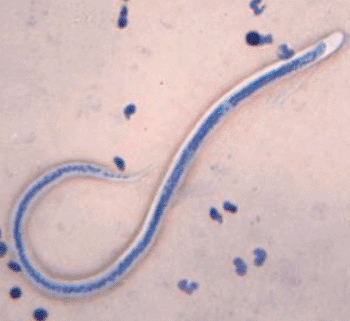Improved Antigen Test Detects Filarial Infection
By LabMedica International staff writers
Posted on 05 Jun 2013
A newly introduced diagnostic test for a worm infection that can lead to severe enlargement and deformities of the legs and genitals is far more sensitive than the currently used test. Posted on 05 Jun 2013
The immunodiagnostic test detects circulating filarial antigen (CFA) in the blood of patients with elephantiasis. It was compared to another commercial card test both in laboratory-banked samples and in fresh samples from the field.

Image: Microfilaria of Wuchereria bancrofti (Photo courtesy of Oregon State Public Health Laboratory).
Infectious diseases specialists at the Washington University School of Medicine (St. Louis, MO, USA) tested a panel of well-characterized serum or plasma samples for both assays in the laboratory. A field study was performed in northwestern Liberia. Blood was collected directly into a small 75-µL blood collection pipette for the Filariasis Test Strip and a 100-µL capillary tube supplied with the BinaxNOW Filariasis card test. Both test strip and card are manufactured by Alere Scarborough Inc. (Scarborough, ME, USA) and are read 10 minutes after application of the blood.
In the laboratory evaluation, the test strip produced stronger, sharper positive test lines than the card, and the test strip was more sensitive than the card test. Both tests detected filarial antigenemia in all 88 samples from subjects with Wuchereria bancrofti microfilaremia. Study participants in the field evaluation ranged in age from six to 89 years, and approximately one-half of the subjects tested were female. The sensitivity of the tests was compared for 503 blood samples that had valid results for both tests. The Filariasis test strip produced 26.5% more positive test results with 124/503 compared with 98/503 for the BinaxNOW card test.
Gary J. Weil, MD, the lead author, said, “The older test has had a major impact, but the new one is even better. Annually, medication to treat and prevent the infection is distributed to more than 500 million people worldwide. The improved sensitivity of the new test will help determine whether the mass treatment program has been effective and also identify regions that need additional attention." The new test strip also has a longer shelf life, estimated at two years without refrigeration, compared with three months for the older version, and it is expected to cost less. The study was published on May 20, 2013, in the American Journal of Tropical Medicine and Hygiene.
Related Links:
Washington University School of Medicine
Alere Scarborough Inc













